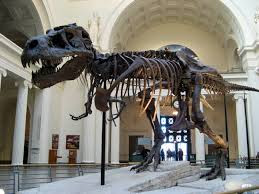I am fascinated by fossils and always have been.
You will find me on most country or beach walks, with the family, poking about on the surface with a boot-end looking for that irregular bit of rock fragment that promises a startling find.....but mostly not.
I have a big collection of one of the most common fossils, the devils toe nail. It is for its ordinariness still distinctive being smooth curled and in varying sizes.
My best find?
A large fossilised shell embedded in clay that I simply dug out of a railway cutting.
I can therefore well imagine the excitement of a Paleontologist in August 1990 who found, in the hills of South Dakota, the most complete fossilised skeleton of a Tyrannosaurus Rex ever to be offered up from the soil.
It was a discovery of great scientific significance and yet it set off a chain of events that involved legal wrangles, the involvement of the FBI, confiscation and even a custodial sentence for the Principal of the excavation team.
The Black Hills Institute, headed up by a Peter Larson was a commercial company whose main activity was sourcing fossils on private land by negotiation with owners and then selling them to museums or private collectors.
This form of business was condemned by the scientific world as being damaging to precious natural artefacts with Larson regularly having to defend the ethics and practices of his organisation.
The first indications of the magnitude of the discovery were quite modest with just two vertebrae bone fragments scattered at the base of a cliff obviously having been ejected following erosion and weathering of the rocky soils. The bones were larger than average and a honeycomb lattice could only be from the largest of dinosaurs. The terrain was rough and unstable on the cliff running down to a grassy plain at its base.
Upon closer scrutiny 3 more vertebrae were found and on a wider radius there were many more interesting pieces. Larson and the Paleontologist, Sue Hendrickson immediately established a camp at the site and over the next 17 days on a thirty foot radius found the almost complete skeletal remains of a female T-Rex.
A larger team worked entirely by hand to reveal the 66 million year old remains. Once released from the support provided by the soil there was a real risk of the bones disintegrating and a special process to apply a consolidant substance was necessary.
Under the agreement with the Native American landowner a finders fee of $5000 dollars was paid. He was happy with the deal.
The commercial prospects for the find were potentially huge in not only monetary terms but also for the prestige and visitor pull for the host museum, in this case the Hill City Museum in South Dakota.
To get the skeleton into preserved and presentable condition took around 25,000 hours of work which Black Hills Institute cited as a particularly important aspect of a commercially funded company and something not readily available to State Departments.
Further research at the site revealed the fossilised remains of two other T-Rex apparently killed at the same time and possibly in a fight with others over territory or food.
Soon after the opening of the exhibit to the public there began a legal battle over disputed ownership.
The Native American beneficiary of the $5000 changed his mind. The land he occupied was in Government Trustee hands and they too began to sue for possession.
In 1992 Peter Larson was accused by the FBI of hiding the dinosaur inspite of thousands of visitors having seen the restoration project under way. He was later imprisoned for 2 years on unrelated dinosaur charges. The T Rex was confiscated and returned to the original landowner.
The residents of Hill City objected strongly with marches and demonstrations but to no avail. At auction a record price of $8.6 million was paid by The Field Museum in Chicago and a new permanent home was secured.
Larson remains unapologetic about the commercial activities of his organisation and indeed feels that the realised monies only served to validate the good job done at all stages by his team to save such a significant discovery. He is also encouraged by the level of interest in all things fossilised but of course that is what his business plan depends on.
Sue, the T Rex in Chicago. Named after her discoverer, Sue Hendrickson

No comments:
Post a Comment